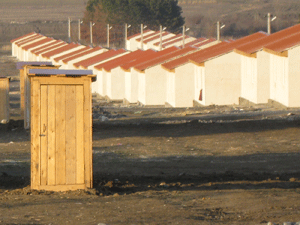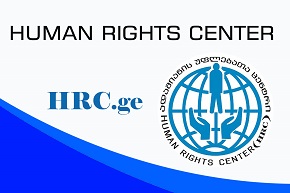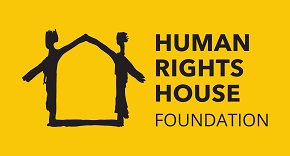“Can You Name Any Other State Which Did the Same?” – The World Bank Likes Cottages for IDPs
May 7, 2010
Saba Tsitsikashvili, Gori
 Transparency International – Georgia published next report about the cottages of the internally displaced people (IDPs). Besides the living conditions, which are described in the report, it also states that international donor organizations intend to allocate additional funds for the reconstruction of the defected cottages. Supposedly, it will happen after the one-year guarantee of the building companies expires – or when the companies will not be obliged to reconstruct the cottages according to the agreement.
Transparency International – Georgia published next report about the cottages of the internally displaced people (IDPs). Besides the living conditions, which are described in the report, it also states that international donor organizations intend to allocate additional funds for the reconstruction of the defected cottages. Supposedly, it will happen after the one-year guarantee of the building companies expires – or when the companies will not be obliged to reconstruct the cottages according to the agreement.
“Perfect!” The World Bank Is Delighted with Cottages
The living conditions in the new cottages are far from the ideal; the most vivid problems are – wet and cold rooms – and it was explained by the high speed in planning and construction and poor availability of the building materials. Because of the damp walls many other defects were originated in the cottages and Georgian media and many local NGOs strictly criticized the cottage settlements.
The minister of refugees and accommodation of Georgia Koba Subeliani denied most part of the accusations in his conversation with the Transparency International – Georgia and said that the accusations were designed for yellow press by “politicized NGOs.” “When we learn about problems from media, we immediately go to the villages and look for the house which was described in the article. The owner of the cottage, as a rule, tells us that representatives of a certain NGO visited them, saw that the removed paint on the wall and concluded that the wall pulled down.”
The institutions and organizations involved in the planning and construction of the cottages said in their conversation with the Transparency International – Georgia that the problems were inevitable due to the situation when the construction was going on.
Chief specialist of the urban management at the World Bank Ahmed Eiveida (who involved the initial stage of planning and later in the process of the cottage funding) said that the problems can be justified: “During similar rapid response the government had to find the balance among three issues: they were the speed, expenditure and quality. It is almost impossible to preserve all three components at high level. If you manage to do the two of them at a high level, then – Good For You.”
The World Bank has allocated preferential loan to Georgia for the construction of the one part of new cottages. Eiveida said: “The government did not scant in expenditure. The IDPs have TV-sets, furniture, etc. Can you name any other country which did the same?”
The minister of refugees and accommodation protects the high speed in the construction. “Three months after the ceasefire nobody lived in the tents. People still live in tents in Sri-Lanka.” Maybe, this evaluation is exaggerating, but its essence is important because it explains the decision of the government on rapid construction.
Evaluation of the Cottage Quality by Independent Engineer
The group of researchers and independent engineer of the TI-Georgia visited five new settlements of the IDPs in March of 2009. They visited Karaleti, Khurvaleti, Shavshvebi, Skra and Berbuki during two days. In December of 2009, they visited four settlements – Karaleti, Khurvaleti, Shavshvebi and Akhalsopeli in one day.
The groups examined the cottages inside and outside. Having discovered the defects, in order to get additional clarifications, they interviewed the residents of those cottages. During the third visit, foreign engineer, who has large international and Georgian experience, examined the technical design of the cottages. He was consultant of the TI-Georgia when working on the report.
The independent engineer concluded that most problems were caused not by the speed of the construction, as the TI-Georgia and others supposed, but because of the mistakes made during architectural planning.
Nigel Rutilo, engineer of the Georgian Reconstruction and Development Company, who examined the architectural projects of the cottage settlements, clarified why the cottages are still wet.
He said that first of all we have to study the physical quality of the construction materials. The concrete is not water-proof material if it is not mixed up with some other substance or if it is used without any protection. The walls of the cottages are built by concrete blocks (which are made of water, cement, sand and hard materials like stones) and holes are left in them which enables the water (rain or priming waters) to leak into the walls.
In order to avoid similar problem, very thick walls were to be constructed whose width was to be between 50 centimeters and 1 meter. In this case, the rain leaks into the walls but since they are wide, it cannot reach the interior. Mr. Ritulo said that construction of similar walls is very expensive. In Georgian cottages, the width of the walls does not exceed 20 centimeters.
Currently, the World Bank, European Commission and USAID together with the municipal development fund work on the new financial packet which will fund the improvement of the defects in the initial planning of the cottages. Supposedly, the reconstruction activities will be carried out in Spring-Summer of 2010. However, by the time the report was published, the new details of funding were not known yet. It is not settled yet what kind of activities will be carried out and how much money will be spent on them in total.
Construction Process and Expenditure
Experts of the TI-Georgia think that the problems in the construction of the cottages can be divided in two categories.
1.The defects caused by the government. These defects are results of the mistakes made in the architecture plans and high speed of construction, for what the government gave limited time to the building companies. These defects are the problems caused by the wet; for example removed paint, must, holes between the floor-boards, etc (according to the municipal development fund, these are defects of the inner walls, ceiling and floor). The government takes responsibility to improve the defects.
2.The defects caused by the building companies. These defects are results of the inattentive, incompetent and rapid work. Those defects are badly-installed doors and windows, the cement fallen from the stair-cases, insufficient construction materials (for example, boards are not installed under the floor), damaged handles on the windows and doors and other similar problems.
The Companies Partly Eradicated Defects in Khurvaleti Settlement
The TI-Georgia got hold of the list of defects in Khurvaleti settlement and the signatures of the IDPs; consequently, the experts arrived in the settlement on January 14, 2010 to evaluate the implemented work. They selected 12 cottages at random, examined each of them and interviewed the inhabitants.
The survey of the TI-Georgia exposed that although the reconstruction activities were carried out in every cottage, the problems still remained in almost half of the examined cottages. There are several explanations of this fact: in several cottages the building companies eradicated only part of the defects (for example, in one cottage the stairs were repaired but the window was the old damaged one; though the window was also on the list of the defects which were improved according to the municipal development fund and the inhabitants had confirmed it by signature that both problems were resolved in their house), in some cottages, the fund had not listed the defects completely.
News
December 13, 2023
Ethnic minorities outside the peace dialogue
November 6, 2023
‘Peace’ agenda of political parties
Popular
Articles
February 13, 2024



